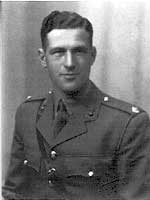|
Charles Jeffrey |
||
Age
25
Married Lieutenant
273065 Killed
in action on
|
In 1919 at the age of two, Charles Jeffrey came to Sabden from Portugal with his parents, Robert and Jane, and his two older brothers, John and Robert, to stay at the Rydal Mount home of Jane Jeffrey’s sister, Mrs Annie Wood. The two sisters, who were Scottish, had met their husbands whilst working in a printworks in Lisbon, Portugal. Mrs Woods husband, Raymond returned home to his native Sabden with his wife at the outbreak of the Great War so he could enlist with his friends. Sadly he was to die of pneumonia in 1918 whilst serving in India. The
Jeffrey family, now with another son Leonard, first moved to Thorn
Street before settling on Watt Street, Sabden.
At the age of five, Charles attended Sabden Council School and
after passing his exams at the age of eleven,
went on to the Burnley Junior Commercial School.
When Charles was fifteen the family moved to The Chapel House,
Hebrew Road, Burnley where his
father
became caretaker at the Ebenezer Baptist Church and Sunday School. At the outbreak of World War 2 Charles, who was working at Messr’s Kneeshaw and Moffat Chartered Accountants, Burnley, enlisted into the R.A.O.C and served in France until the evacuation of Dunkirk in 1940. On being commissioned in April 1943 he was transferred to the Royal Artillery. In
June 1942 Charles returned to Sabden when he was best man at the wedding
of Harold Bridge and Marion Parfitt.
It was Mr and Mrs Bridge who arranged for him to meet another
friend of theirs, Alice Wood, whilst they were both stationed
in London.
Alice was serving in the W.A.A.F as a driver to the famous
organist Reginald Dixon, who at the time was an officer in the R.A.F.
Charles was to visit Sabden for the last time when he married
Alice at the village Baptist Chapel in July 1943.
Charles,
now serving in the East Lancashire Regiment went out to France on the 28th
June 1944.
They were sent to the Caen area of Normandy where the Germans had
so far repulsed the allies' attempts to capture the town, inflicting
heavy losses.
On the 16th July, Charles’s company was to take part
in an attack to capture a stretch of the Villers-Bocage-Road.
The start time was 05.30 and almost immediately came under heavy
resistance.
Shortly after 07.30,
whilst trying to outflank an enemy position, Charles was killed.
The objective wasn’t captured until 48 hours later at a cost of
over 200 casualties.
Charles
was buried at the Fontenay-le-Pesnel War Cemetery, Tessel, Calvados,
France. In Sabden his name does not appear on either the school or church memorial plaques.
|
|

